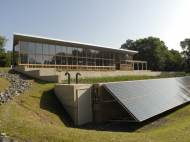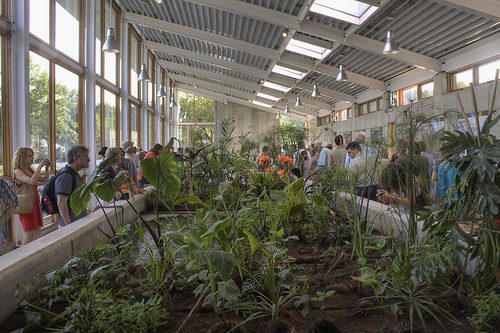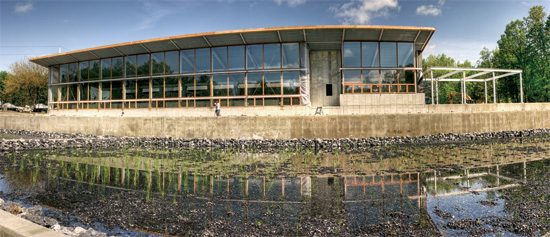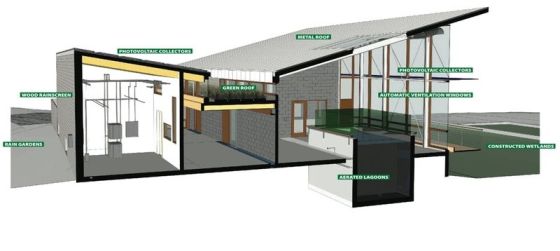Green architecture – Omega Center for Sustainable Living
 The Omega Center for Sustainable Living (OCSL) in Rhinebeck, New York is carbon neutral and produces 100 percent of its own energy through solar and geothermal power. OCSL officially opened on July 16th 2009 and it is on track to receive a LEED Platinum Certification, which cannot be officially granted until the building has been in operation for a year. LEED, (Leadership in Energy and Environmental Design) is designed by the U.S. Green Building Council which has created standards for sustainable design. OCSL is also the first building in the U.S. be designated a Living Building.
The Omega Center for Sustainable Living (OCSL) in Rhinebeck, New York is carbon neutral and produces 100 percent of its own energy through solar and geothermal power. OCSL officially opened on July 16th 2009 and it is on track to receive a LEED Platinum Certification, which cannot be officially granted until the building has been in operation for a year. LEED, (Leadership in Energy and Environmental Design) is designed by the U.S. Green Building Council which has created standards for sustainable design. OCSL is also the first building in the U.S. be designated a Living Building.
For a building to qualify as Living, its site, energy, materials, water, indoor quality, and beauty must meet certain criteria. According to the Omega Web site, a Living Building must, “Be informed by their eco-region’s characteristics; generate all of their own energy with renewable resources; capture and treat all of their water; operate efficiently; and be designed for maximum beauty.”
“The OCSL is a dynamic, living and breathing demonstration of how interconnected we all are with the world around us,” said Skip Backus, chief executive officer at Omega. “Our goal is to help people reexamine how they relate to the world by showing them what’s possible in terms of environmental sustainability and green energy. Omega is very proud to be at the forefront of this movement.”
The OCSL was designed by Kansas City based BNIM Architects, renowned for sustainable design. The OCSL supplies all of its own energy needs and its operation is carbon neutral. The self-sustaining building is heated and cooled using geothermal systems, and utilizes photovoltaic power. It will serve as the heart of Omega’s ongoing environmental initiatives and includes a greenhouse, an Eco-Machine, constructed wetlands, and a classroom that will be open year-round to the public.
The center has several classrooms, but at the core of the 575 square-meter center is a 418 square-meter greenhouse containing a water filtration system called the Eco-Machine designed by John Tood Ecological Design. This living system uses plants, bacteria, algae, snails, and fungi to recycle Omega’s wastewater (nearly 19 million liters per year) into clean water that is used to restore the aquifer.
The four-step water treatment at Omega is quite impressive. A 38,000 liters anoxic (oxygen-free) tank collects all the wastewater from the whole campus of the Omega Institute. The tank is placed so that water can flow downward as it is being cleaned, minimizing the need for energy-hogging pumps.
BNIM designed artificial wetlands to serve as the second stage of the treatment process. Water flows from the anoxic tank into gravel-filled cells filled with stands of bulrush and cattail. The plants ingest nitrates and other impurities.
From the wetlands, the water moves inside the building into two lagoons that are divided into cells. Plants such as calla lily and giant papyrus hover just above water level, their roots working alongside a variety of fungi, microbes, algae, and snails to clean the water as it moves through the cells. Koi swim in the last, cleanest cell.
Skylights above the lagoons let in sunshine to nourish the plants. A solar-tracking system follows the sun through the day, diverting rays downward for steady light. Clear water flows back outside from the lagoons into a filter of sand and gravel. Microorganisms living in the sand devour residual waste before the cleaned water is piped to flush toilets and irrigate the land.
The green roof collects and cleans rainwater before diverting it to a cistern. After studying wind patterns, BNIM designed the lower windows on the east side and the upper ones on the west to open and cool the building in the summer.
Using slabs of cypress reclaimed from a Pennsylvania mushroom farm (all building materials had to be recycled or come from within 1,600km of the site) BNIM constructed a sheath around the building to prevent moisture buildup and provide extra insulation. Photovoltaic collectors allow the building to be entirely off-grid.
“The OCSL is truly a world in miniature—it is rewriting the rules for sustainability,” said John Todd, ecological designer and developer of the Eco Machine. “By working to meet the Living Building Challenge, the OCSL pushed the design envelope to allow this building to live in the sacred ecology that connects each of us to one another.”












I find these rare practices very important to be held as example for mainstream architectural convenience and cost optimization.
The cost of the OCSL was 35 to 40 percent more than a traditional building, but it will pay for itself in the long run, because it is “virtually cost free, except for maintenance.”
http://ecofuture.net/enzo/2009/07/29/omega-center-for-sustainable-living-ocsl-first-living-building-in-usa/
This is nice information you posted here. I am planning to make something like this for my place. I think maintenance is considered as the hardest part here.
Excellent Green Architecture.
Dr.A.Jagadeesh Nellore(AP),India